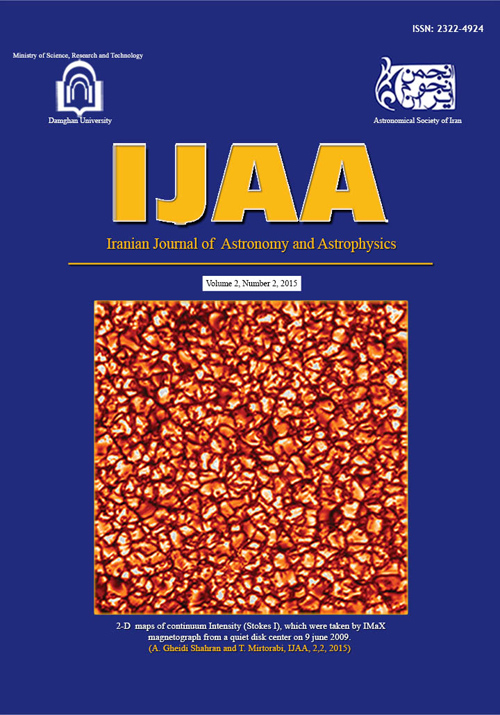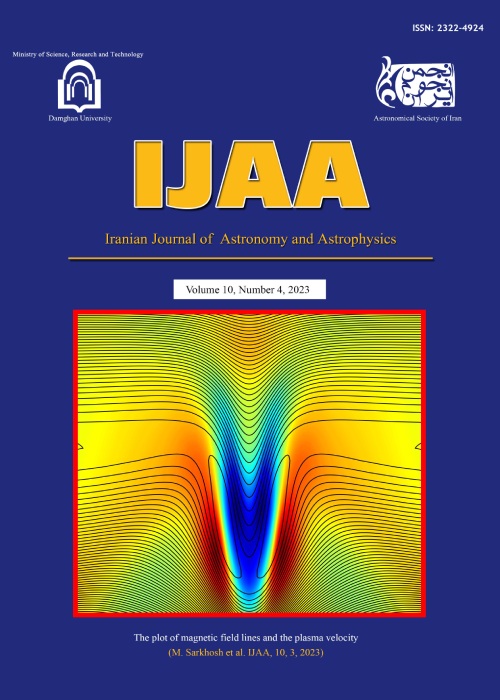فهرست مطالب

Iranian Journal of Astronomy and Astrophysic
Volume:2 Issue: 2, Autumn 2015
- تاریخ انتشار: 1395/07/13
- تعداد عناوین: 6
-
-
Pages 109-119Distribution of magnetic fields in the quiet-Sun internetwork areas has been affected by weak polarization (in particular Stokes Q and U) signals. To improve the signal-to-noise ratio (SNR) of the weak polarization signals, several approaches, including temporal integrations, have been proposed in the literature. In this study, we aim to investigate a proper temporal-integration time with which an optimum SNR maintained physical properties is obtained. We use magnetographs of Zeeman sensitive Fe I 5250.2 Ǻ line recorded by Sunrise/IMaX to determine fraction of areas with significant polarization signals after temporal integrations with different durations. We examine several thresholds for the noise level. We also perform simple numerical simulations to explore the effect of size and lifetime of the magnetic features in obtaining the proper integration time. We find that the maximum fraction of pixels with real detectable linear polarization signals in the quiet-Sun internetwork is achieved with a maximum integration time about 8 minutes. Variation of polarization signals with integration time is strongly dependent on lifetime and size of magnetic patches. The temporal integration should be performed with great caution since in the presence of relatively long-lived magnetic features (such as network patches) SNR increases monotonically by increasing the integration time. This monotonic increase does not necessarily correspond to the internetwork areas where the linear magnetic features are relatively short-lived.Keywords: Sun: photosphere, Sun: magnetic elds, techniques: polarimetric
-
Pages 121-125We want to nd the cosmological constant in uence on cosmic microwave background (CMB) temperature due to moving linear cosmic strings. Using the space- time metric of a linear cosmic string in an accelerated expanding universe, the Gott- Kaiser-Stebbins (GKS) e ect, as an important mechanism in producing temperature discontinuity in the (CMB), is considered; then, its modi cation due to the e ect of the cosmological constant is calculated. The result shows that a positive cosmological constant (i.e. the presence of cosmic strings in an accelerated expanding universe) weakens the discontinuity in temperature so that a stronger resolution is needed to detect the corresponding in uences on the CMB power spectrum and anisotropy.Keywords: ISM: Cosmic Strings, Cosmological Constant, Cosmic Microwave Background (CMB)
-
Pages 127-138We study the dynamics of two three-level atoms interacting with independent bosonic Lorentzian reservoirs at zero temperature. Such systems can be created in far astronomical objects. Quantum mechanical behaviour of these particles can produce detectable effects on the spectroscopic identifications of these objects, if such behaviour remain stable during the interaction with their media. It is shown that de-tuning increases the robustness of negativity and geometric discord as the measures of entanglement and quantum correlation beyond entanglement, respectively against interaction with reservoirs. In separable and bound entangled regions, negativity is zero while the geometric discord remains not zero. We also study the evolution of geometric discord and negativity for an isotropic state.Keywords: Entanglement, Quantum discord, Negativity, qutrit
-
Pages 139-151Head on collision of localized waves in cold and dense hadronic matter with and without shear and bulk viscosities is investigated. Non-relativistic dynamics of propagating waves is studied using the hydrodynamics description of the system and suitable equation of state. It will be shown that the localized waves are described by solutions of the Burgers equation. Simulations show that the propagating waves in viscous media travel longer distances in comparison with inviscid similar fluids. In this way, the traveling distance of localized waves is a suitable criterion for evaluating the viscosity of hadronic fluids.
-
Pages 153-159We want to study the perturbation growth of an initial seed of an ellipsoidal shape in Top-Hat collapse model of the structure formation in the Modi ed Chaplygin gas cosmology. Considering reasonable values of the constants and the parameters of the model under study, we can show that a very small deviation from spherical symmetry (ellipsoidal geometry) in the initial seed leads to a nal highly non-spherical structure which can be considered as a candidate for justifying the already known cosmological structures as cosmic walls and laments.Keywords: Structure formation, Chaplygin gas, Non, spherical collapse, Cosmic walls, Filaments
-
Pages 161-173We have carried out a series of small scale collisional N-body calculations of single-mass star clusters to investigate the dependence of the lifetime of star clusters on their initial parameters. Our models move through an external galaxy potential with a logarithmic density profile and they are limited by a cut-off radius. In order to find scaling relations between the lifetime of star clusters and their initial conditions including the initial mass, size and galactocentric distance, we vary the initial conditions and measure the final half mass radius and dissolution time of each cluster. We show that the lifetime of star clusters scales with the initial half-mass radius, galactocentric distance, and initial mass as Tdiss~R0.15h, Tdiss~R0.94 G , and Tdiss∝M0.45i , respectively. Our results are in remarkable agreement with the previous works by Baumgardt & Makino (2003) and Haghi et al. (2014) who have found some scaling relations for the lifetime of multi-mass star clusters with a large number of stars including the stellar evolution. Moreover, we find that all clusters with the same mass and different initial half-mass radius, converge to an equilibrium value of half-mass radius, after core collapse that scales with galactocentric distance as Rh~R0:8 G. We show that the exponent in this scaling relation is slightly larger for the massive star clusters.Keywords: galaxies: star clusters, method: numerical


